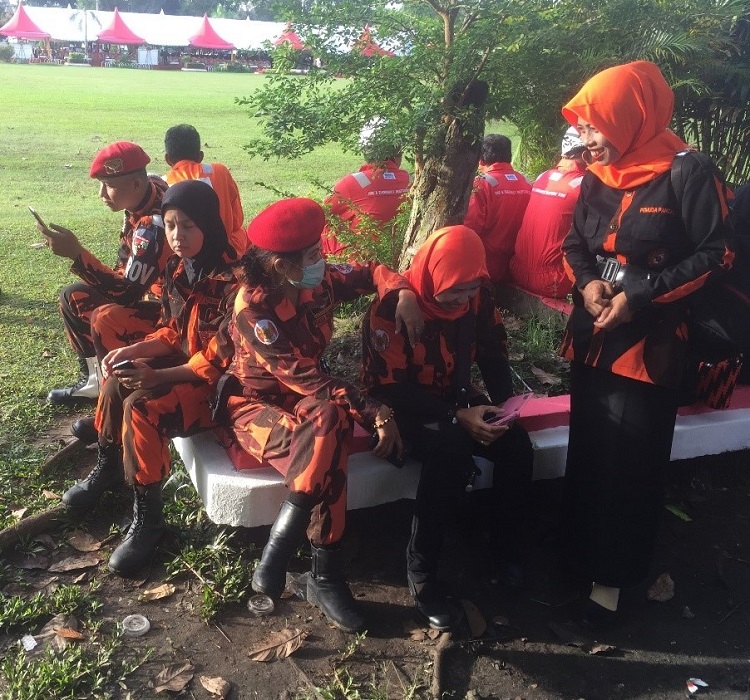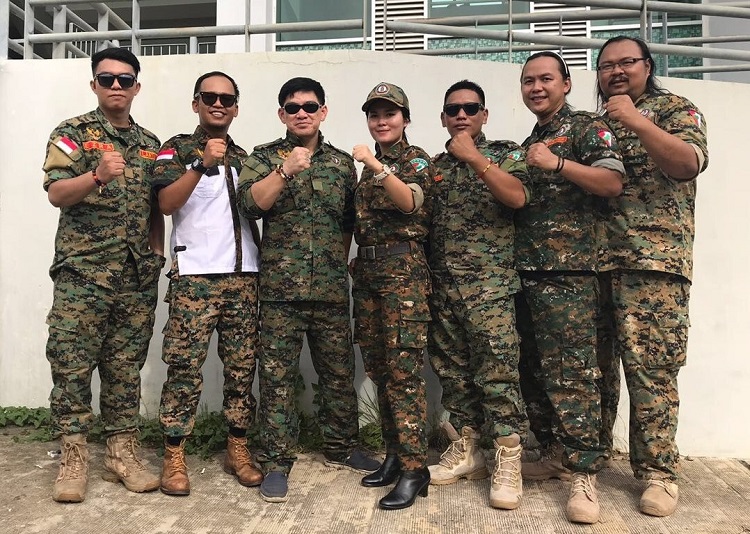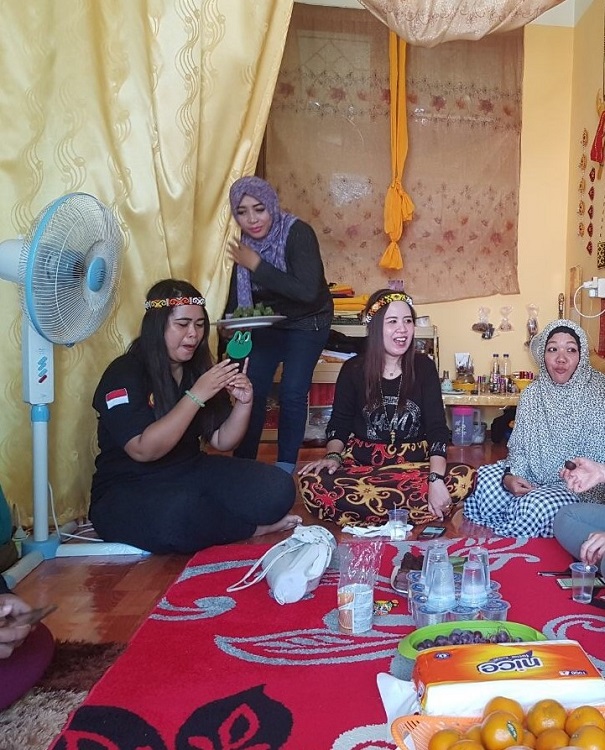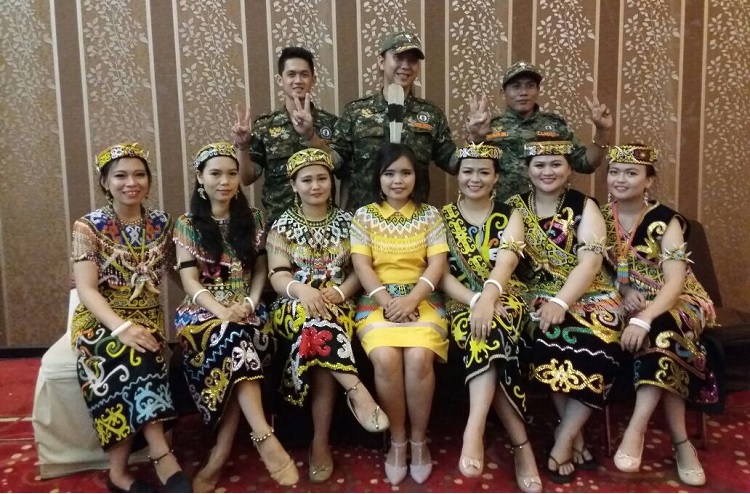Women in East Kalimantan join male-dominated ‘ormas’ to empower themselves and their community
Women in East Kalimantan join male-dominated ‘ormas’ to empower themselves and their community
Lotte Troost
Of three women joining a meeting of GEPAK, the Indigenous Youth Movement of Kalimantan, only Amoy is sitting in the circle formed by the male members. With her black cap, matching her black-collared GEPAK shirt with sleeves wrapped around her muscular arms, she leaves an imposing impression.
Her male fellows call her the daredevil. She tends towards ‘berani’ (courageous) rather than traditional values of womanhood, as an obedient wife and mother. GEPAK, from Gerakan Pemuda Asli Kalimantan, is a local ethnic ‘ormas’ (organisasi kemasyarakatan, or community organisation) in East Kalimantan. Members meet twice a month. During the group photo Amoy confidently takes her position in the middle of the men and raises her thumb for the picture. ‘Satu GEPAK!’ they shout together.
Elsewhere, armed with her designer handbag and her shiny sunglasses, Mei takes her position in the restaurant. Beauty is this lady’s weapon. ‘It is an important asset for me as a person, as well as for my activities in the ormas I used to lead, the Troops of Traditional Dayak Youth of East Kalimantan (LPDAKT or Laskar Pemuda Dayak Adat Kalimantan Timur). Regardless of her intelligence, her considerable outspokenness, and her up-to-date knowledge of politics and current affairs, she never leaves the house without a well-groomed appearance. Playing up her femininity proves to be beneficial in her dealings with authorities. On a prior visit to the salon, some improvised theatre – such as wailing and promising to go out for a drink or karaoke – proved to be the decisive factor during negotiations with police about the release from prison of her male LPDAKT comrades. ‘Playing with the psychology of men’, she likes to call her way of being ‘berani’.

Two stories, two women, both of whom are active in a traditionally male-dominated ormas in Balikpapan, East Kalimantan. Though they have different styles and appearances, they are similarly driven to ormas activism to address grievances they have with their society, especially concerning the position of local women in East Kalimantan. For increasing numbers of women who join organisations like GEPAK and LPDAKT, ormas activism helps them to overcome personal hardships and to regain ownership of their life.
Women in a men’s world
Ormas are a well-known and somewhat notorious phenomenon in Indonesia. Throughout the country, these non-state, civil organisations claim to represent socially, politically and economically deprived groups in society. They often do so by combining advocacy for local needs with the threat of violence and intimidation, as shows most clearly from their ‘preman’ (gangster) appearances. During Suharto’s presidency, the regime often used preman to keep control over society, mainly by attacking regime opponents. Preman who did well could climb through the regime ranks; it is this status on which current ormas base their legitimacy. During the New Order, preman were strongly associated with crime, imposing with their physique and their readiness for violence. This image is still visible in the performative style and appearances of today’s ormas. It is not uncommon to see members wearing a camouflaged military uniform when enforcing rules or behaviours. Or to see them shouting and clenching their fists as they protest against ‘bad’ influences in public life such as religious extremism.
Female ormas members often emulate this style – except for those using their femininity strategically, like Mei. In Balikpapan I once met Ika, a female member of Indonesia’s largest ormas, Pemuda Pancasila (Pancasila Youth). She combines her military outfit with a belt in which she keeps her knife. ‘I don’t intend to use it; it is just for emergencies, such as when we had a conflict with GEPAK in 2014.’ Amoy’s social media is also filled with pictures of her wearing her camouflage-patterned GEPAK jacket, with the organisation’s logo – a knife and a spear – sewn on the jacket. However, for women, such ‘berani’ traits are commonly considered deviant.
The traditionally preman appearance conforms to the normative male performance of physical prowess and ‘berani’ behaviour. This image of the ideal man was once actively promoted through Suharto’s state gender ideology, which also emphasised the domestic sphere as the proper place for women, to fulfil their ‘destiny’ as obedient wives and mothers. Accordingly, ‘berani’ is considered inappropriate or even dangerous behaviour for women. Such notions continue to influence perceptions of the position of women in contemporary Indonesia. Despite the increasing presence of strong women in positions of power, ordinary women are still expected to remain in the background. Thus, women’s activism in ormas seems to be a peculiar phenomenon.

Indeed, women who join ormas are often confronted with negative reactions, such as the suggestion that they are a bad mother or disobedient wife. Yet, these women are determined to claim their agency in the public sphere and to voice their concerns. They spend much of their time and resources on their ormas and willingly adapt to the male-dominated environment, because they are no less motivated than the men to defend their community’s interests, to preserve and promote the Indigenous Dayak identity in local politics and development, and to secure their city from the ‘outside threat’ of religious extremism. But the women have additional motives for joining such groups, due to the double burden of belonging to a deprived community and suffering hardships specific to being a woman.
Double burden, double courage
Many members of GEPAK and LPDAKT are of Dayak ethnicity – the majority ethnic group in East Kalimantan – or they profile themselves as such by wearing traditonal Dayak clothing or ornaments, utilising the Dayak identity as a unifying factor for mobilisation. In the past, the Dayak were marked by relatively well-balanced gender relations. For example, gender was not a decisive factor in gaining authority or inheriting land. Age was considered more crucial.
Under Suharto’s regime, however, the once powerful Dayak women had to fight a double battle. They felt downgraded for being women and for being marked as a ‘backward’ ethnic group by the Suharto government, whose Java-centric policies did not leave much room for Indigenous communities to practice their cultures. As a result, traditional lifestyles have been almost wiped out. Furthermore, Indigenous communities were subjected to discriminatory and paternalistic development projects. Land to which they claimed customary rights has been stripped by large-scale commercial logging companies and oil palm estates that prefer to use migrant labour rather than employing the local community.
Native interests were also threatened by migrants who arrived in East Kalimantan by state-led transmigration programs and were granted the land of the original inhabitants, exacerbating the Dayaks’ feeling of marginalisation. In recent years, the environmental and social ramifications of land claims have fueled several conflicts over access and rights to land and natural resources. Local communities typically lose out due to (local) governments’ ignorance of their customary-based land rights and usage.
Within these conflicts, Indigenous women are most often hit the hardest. Once considered the powerful owners of their land and its resources, they have lost their economic independence. Although some of the traditional landowners might find new employment or receive financial compensation for the loss of their land, this mostly applies to men. This creates an economic disparity that benefits men and often brings with it a shift in decision-making power within the household, where the husband feels more entitled to spend family income on personal needs, including drugs, alcohol and gambling. Inter-family disputes that emerge from this situation have led to an increase in domestic violence and divorce.
According to Yulita, a gender specialist in the Balikpapan-based NGO Prakarsa Borneo, divorce is not an easy option due to women’s economic dependence on their husbands, and many divorced women desperately resort to prostitution to make ends meet. ‘When the wife asks for divorce, economic hardship will follow. And in a transit city like Balikpapan, where many male mining and oil workers stay over during the weekend, prostitution is an easy way for women to quickly get some money.’ Yulita adds that getting divorced requires women to be ‘twice as courageous’, as they are often the ones who are blamed and stigmatised for the case, especially within Islamic culture.
Not all female members of ormas have experienced domestic violence or divorce, but the considerable number that have certainly demonstrate double courage. Siti (not her real name), for example, explains how joining LPDAKT helped her to overcome her hardship. ‘My ex-husband was addicted to narcotics, therefore we had a lot of financial troubles’, she recalls. ‘The situation worsened and my husband started to abuse me and in the end I tried to suicide twice. Both times I survived, which made me realise God has a different plan for me.’ She divorced her husband and became active in LPDAKT. ‘The ormas helps me to forget my traumatic past, to benefit from the protection of the masses, to regain respect and thus develop my self-esteem that was totally gone after what happened.’ She said her traumatic past and surviving a violent husband created an ‘I don’t care mentality’ that has helped her to climb up in the organisation. Striving for a ‘good future’ for her son in East Kalimantan further adds to her motivation. Eventually Siti even met her new boyfriend in LPDAKT.
Self-empowerment
It is not surprising that women in this region have made use of increased political and social freedoms after Suharto’s resignation to organise themselves – striving for social justice, political power and wider recognition of their Indigenous culture, as well as improvement of their personal situation. Being a member of an ormas like GEPAK or LPDAKT offers these women a sense of empowerment. It also offers much-needed protection for those who have suffered domestic violence or are divorced, as many ormas provide consultation services and legal aid and support women to start their own business. Members are also backed by a big group that will come to their defense when needed.

Above all, the ormas offers the women a channel to express and overcome their feelings of marginalisation. In Kawan GEPAK (Friends of GEPAK), the women’s wing of GEPAK, women gather together and discuss their issues. These gatherings provide them with opportunities to expand their social network and develop social capital, including enhancing their skills, self-confidence and knowledge about politics. Many activities also focus on increasing members’ economic independence while providing a safety net in times of need. Members educate each other about women’s rights and inspire other women who find themselves in the same position, like a sisterhood. ‘I never met Mei in person, but we are friends on Facebook’, the sister-in-law of my landlord in Balikpapan once told me. ‘I like to follow her activities on social media, as she shares about her demonstrations and her leadership. She is an inspiration for me.’
As the central government has failed to address their problems, these women feel the need to take matters into their own hands. Especially for divorced women or those who have suffered domestic violence, joining an ormas seems more approachable than contacting an NGO or seeking local government assistance. Many consider NGOs as lacking the decisive power to pursue demands or to make an impact, while the government is often seen as too bureaucratic or ineffective. Many women also feel reluctant to share their stories with male-dominated institutions, such as the police. These women are more likely to get involved with activists who engage with the local population at a grassroots level and therefore act closer to their community.
In Samarinda I met Dian (not her real name), who talked about her journey with AMAN (Aliansi Masyarakat Adat Nusantara, Indigenous Peoples’ Alliance of the Archipelago), one of the many organisations that straddle the lines between ormas and NGO. ‘I come from West Kutai, a target area for large-scale palm oil, mining and timber companies. Being a farmer, my father was in conflict with these companies about control over land and resources’, she told me. On top of this threat to her family and livelihood, Siti became a victim of domestic violence. But she decided not to be absorbed by her victimhood. ‘I chose to join AMAN to share my story and avoid possible new injustices. I regained my self-esteem and enlarged my network. Joining AMAN brings out the best in me,’ she explains, ‘I became a survivor of marginalisation instead of a victim’.
With Kalimantan designated as the centre for production and processing of national mining and energy reserves – as reconfirmed in the Masterplan for Acceleration and Expansion of Indonesia’s Economic Development (MP3EI) for the period 2011-2025 – a growing number of courageous women follow the lead of Amoy and Mei, and become ormas activists to protect themselves and their community from potential new threats to their wellbeing and livelihood. Be it with a tough appearance or with some extra visits to the beauty salon to manipulate their male opponents.
Lotte Troost (lottetroost@hotmail.com) is a MSc graduate in Contemporary Asian Studies from the University of Amsterdam. She currently studies Indonesian language and culture at Universitas Padjadjaran in Bandung. In 2018 she lived for three months in Balikpapan to do research on ormas organisations in the region, as part of her master thesis ‘Conditions of possibilities: the story of women in ormas organisations in East Kalimantan’.
